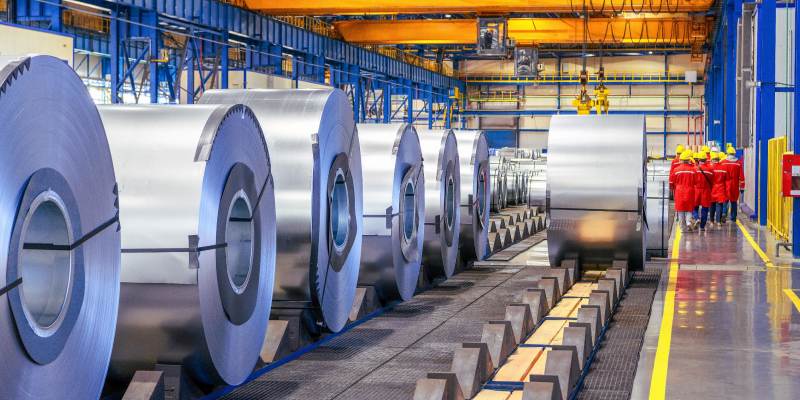Grasping the differences between hot rolled and cold rolled steel is crucial, especially when selecting high-quality materials. For instance, a steel pipes manufacturer must consider how each option affects the texture, strength, and overall suitability of the final product. This article delves into these distinctions, offering valuable insights to guide you toward an informed decision.
Exploring the Hot Rolled Steel Process
What is hot rolled steel? Is hot rolled steel ideal for my project? Which process suits my projects the best? Let us develop an understanding of the hot rolled process. The hot rolled process begins with heating a billet or slab. Subsequently, it is rolled to shape. The process involves temperatures like 1700 degrees Fahrenheit (926 degrees Celsius) or more. Such heat renders the steel malleable, facilitating shaping without fracturing. Through rolling mills, the fiery steel gradually thins and assumes the desired form.
Benefits of Hot Rolled Steel
A project that demands strength and cost effectiveness calls for hot rolled steel with its specific advantages, such as:
- Cost efficiency, particularly for extensive production runs.
- High strength and ductility for diverse applications.
- Swift production, facilitating quicker project completion.
These benefits position hot rolled steel as ideal for work with tight schedules and for speeding up projects under way.
Primary Applications
- Structures within buildings and large construction projects.
- Production of agricultural machinery.
- To manufacture components for automobiles like frames and wheel rims.
- Railroad equipment, including tracks and railcar parts.
Its versatility of hot rolled steel makes it ideal for numerous products and structures because of its significance in construction and manufacturing.
Suitability for Projects
Hot rolled steel is used in projects where exact dimensions are not critical. The hot rolled steel may lack the tight tolerance that cold rolled steel has. However, for many construction and industrial uses, minor dimensional variations are insignificant. This renders hot rolled steel a practical option for projects where strength and cost outweigh the need for precision.
Disadvantages of Hot Rolled Steel
Opting for hot rolled steel necessitates weighing its cons, especially if your project demands exact dimensions and superior surface finish. The primary drawback of this type of steel is its lack of precision due to the metal's expansion and contraction during heating and cooling. Using it may result in a product that fails to meet the exact standards of measurement. Moreover, the surface quality often does not match expectations. The rough texture, resulting from scaling during heating, might need additional treatments like grinding or polishing, elevating the project's cost and expanding project-timelines. Minor distortions can also emerge as the steel cools, potentially affecting the straightness and uniformity of the final product or structure. For projects where precision and finish are critical, considering alternatives such as cold rolled steel could be advantageous.
Understanding the Cold Rolled Steel Process
The cold rolling process involves cooling hot rolled steel to room temperature before refining or working on it further. Contrary to hot rolling performed at high temperatures, cold rolling is done at or near room temperature. This variation in processing yields several notable benefits. A significant advantage of cold rolled steel is its tighter dimensional tolerance. This precision is vital for uses where exact measurements are critical. Moreover, cold rolled steel’s surface quality surpasses that of hot rolled steel, offering a smoother and more visually appealing finish.
Benefits and Uses of Cold Rolled Steel
Cold rolled steel is lauded for its high precision and consistency, essential in sectors where these aspects are vital. Its superior surface finish, requiring minimal additional treatment, conserves time and resources, marking it a top pick for detailed and complex but precision
Applications of Cold Rolled Steel
Visual appeal, high precision, surface finish and straightness are characteristics of cold rolled steel. It is known for adapting to exact dimensions and complex shapes with intricate and cross sectional profiles. It is used in:
- Home Appliances
- Metal furniture
- Aerospace Structural Work
- Automotive parts
Suitability for Projects
Cold rolled steel is shiny and energy efficient and contributes to a leaner carbon footprint. These attributes make it more sought after in precision work and sustainability focused sectors. It also has broader implications based on project needs and environmental considerations.
Disadvantages of Cold Rolled Steel
Like hot rolled steel, cold rolled steel has both advantages and disadvantages. Here are the primary disadvantages of cold rolled steel:
- Higher cost due to added processing steps.
- Shape restriction, diminishing its versatility.
These factors, elevated costs and shape restrictions. are crucial considerations when choosing between hot rolled and cold rolled steel for your project's specific requirements.
Also Read: Galvanised Sheet Steel: Powering Industry Through Durability & Innovation
Costs and Environmental Impact Hot vs Cold Rolled Steel
Both hold their ground in the manufacturing and construction realms. Yet their expenses and environmental footprints differ markedly, influencing your projects overall sustainability and budget.
Cost Analysis Comparison
Hot rolled steel typically offers cost effectiveness for extensive production runs. This stems from the process being less labor intensive than cold rolling.
Conversely, cold rolled steel, while delivering tighter dimensional tolerance and a smoother surface finish, incurs a higher cost.
Environmental Impact
Hot rolling consumes considerable energy, mainly due to the need for heating steel to steep temperatures. This method also poses a higher risk to material waste, since scaling during heating needs to be eliminated, resulting in material loss.
In contrast, cold rolling is more energy efficient and sustainable. It involves processing steel at or near room temperature, and uses less energy.
Navigating Your Choice in Steel
Hot rolled and cold rolled steel offer distinct advantages tailored to particular requirements.
Which type to choose is a decision far more complex than a simple preference. Strategic planning for enhanced efficiency, quality, and performance is of primary significance. Whether leaning towards the adaptability and cost efficiency of hot rolled steel to meet the needs of expansive structural projects or the exactness and visual allure of cold rolled steel for intricate designs, your choice significantly influences the project's outcome. At MKK Metals, we understand these nuances and provide expert guidance to ensure you select the ideal steel for your needs. Trust us to help you achieve optimal results and the best value for your projects.

